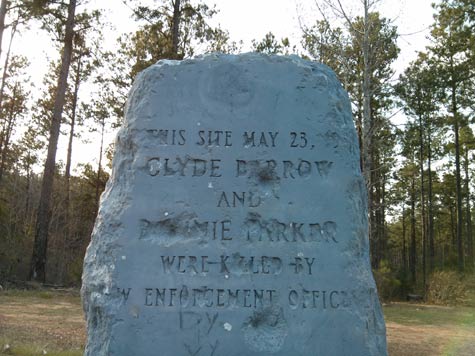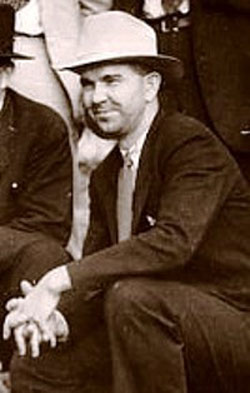 As our rented land barge skirts the Arkansas state line in Bienville Parish, Louisiana, we round the curve of scrub-speckled highway and nearly blow past it. I pull the mineral-gray Taurus onto the gravel and we stretch our legs before approaching the bullet-pocked monolith.
As our rented land barge skirts the Arkansas state line in Bienville Parish, Louisiana, we round the curve of scrub-speckled highway and nearly blow past it. I pull the mineral-gray Taurus onto the gravel and we stretch our legs before approaching the bullet-pocked monolith.
Wilted flowers have been left at its feet. Stones placed on its head. Chips gouged away as souvenirs.
The concrete marker reads:
THIS SITE MAY 23, 1934
CLYDE BARROW
AND
BONNIE PARKER
WERE KILLED BY
LAW ENFORCEMENT OFFICERS
I am at the final battleground of two of the last century’s most notorious criminals, with a distant relative of one of the lawmen who participated in the deadly ambush.
Dapper Dillinger may have been the most famous of the Depression-era bank robbers, but few duos evoke the glorified romance of Bonnie and Clyde. Like most of their kind, their exploits were exaggerated and distorted by law enforcement, historians, and the press. Robin and Marian they were not. The Barrow gang did not hesitate to murder civilians and lawmen alike. They did not rob to fund a lavish celebrity lifestyle like Dillinger. Some history buffs say Clyde stole to fund a war against the Texas prison system, but once you commit to a career of armed robbery and murder, there aren’t many options left.

Clyde Barrow grew up dirt poor, sleeping under his father’s wagon when his family left the farm for Dallas. A youth of thievery got him sentenced to labor in Texas on Eastham Prison Farm, where a fellow inmate raped him repeatedly. Barrow beat the man to death, but came out changed. “He changed from a schoolboy to a rattlesnake,” crook-in-arms Ralph Fults said.
That’s where the stories of revenge come from, but other than a prison break that left a guard dead, and set the Texas Rangers on their tail, there is no real evidence of an anarchic war against authority. Another romantic afterthought.
But their story lends itself to such imaginings. Clyde met Bonnie Parker at a friend’s house, where it was said they were smitten. Afterward, she tagged along on his robberies with the gang. She wrote tragic poetry, like “the Story of Suicide Sal” and “The Trail’s End,” which no journalist could resist. After their Ford took a spill during an escape, she suffered third-degree burns on her leg that crippled her until the day she died. She had to hop on one leg, or Clyde would carry her. They were caught in part because purchasing the medicine for her unhealed burn made them easy to trace.
As Barrow’s rattlesnake personality struck down more law officers and several civilians, the public no longer saw the couple as outlaw lovers defying authority, but as cold-blooded murderers who needed killing.

When Sheriff Jordan (pronounced Jur-dan) learned that Bonnie and Clyde were passing through to rob a bank in neighboring Natchitoches Parish, he took no chances. He cajoled the father of gang member Henry Methvin to jack up his truck on the road as if broken down. When Barrow slowed to offer assistance, the posse opened fire with their battle rifles, unleashing 130 rounds before switching to shotguns and sidearms. The smoking vehicle veered into a ditch, and the men fired until they were absolutely sure that Barrow, known for gunning his way out of many a tight spot, breathed no more.
Students at nearby Arcadia High School ran from the schoolhouse as the bullet-riddled death car was towed into town. One of the young girls was my wife’s mammaw, now ninety-three. The vehicle was put on display at the Ford dealership, and the bodies of Bonnie and Clyde laid out on tables at a local cafe. The town swelled into a carnival as people came to see.
Sheriff Henderson Jordan died in a head-on collision thirty miles from the ambush site, at the age of sixty-five. The twenty-seven years after the shooting had not treated him well. A member of his family wrote that Jordan’s hair seemed to turn white overnight after the ambush, which was never mentioned by the family in deference to his feelings. Reports varied on whether Barrow and Parker were given chance to surrender, tainting the police ambush as premeditated slaughter. The reward money offered for Bonnie and Clyde’s death or capture dried up with the controversy, leaving the hunters who spent months tracking them to fight over souvenirs, their arsenal of firearms, and the car itself, which was returned to the woman it had been stolen from only after a court order. It is currently parked in a casino in Primm, Nevada. Google it if you want the gory details. The cluster of gaping bullet holes is testament to the posse’s marksmanship.
When we visited the ambush site, the road had been paved and the ditch filled and graded. It was quiet as a cemetery. Two hunting beagles spied us from the woods beyond the gruesome site’s desolate marker, then ran as we approached. Someone had left the dogs water bowls and a blue plastic drum with blankets for shelter. I wonder if the two lost pups’ names were Bonnie and Clyde.
Thomas Pluck is the Bullet Award-winning writer of the Denny the Dent stories, as well as hard-boiled and humorous fiction that has appeared in The Utne Reader, Beat to a Pulp, Spinetingler, McSweeney’s, Crimespree Magazine and many others. He is also the editor of the Lost Children anthologies to benefit PROTECT and Children 1st. He is working on his first novel, entitled Bury the Hatchet. Follow him on Twitter @thomaspluck.

Sounds like a fun trip. Love the Bonnie and Clyde stuff.
Maybe the next Bouchercon can be in Arcadia.
Great piece, Pluck! Really enjoyed it.
Nice job, Tom. The family is proud of your journey to the hills of north Louisiana.
The History Channel is debuting their new movie Bonnie and Clyde in two days on the 8th. Hopefully this time The History Channel will adhere to the facts instead of sensationalizing them as they have been known to do in the past.
I’m pretty sure Joplin is in Missouri, not Mississippi
I’m equally sure that his Ford was a model “A” not a model “B”! I liked the story quite a lot.
I’m currently not working, any chance of getting a job proof reading your work? I’m serious.
Actually it was a Model B Ford.
[url=http://en.wikipedia.org/wiki/Ford_Model_B,_Model_18,_%26_Model_40_(1932)]http://en.wikipedia.org/wiki/Ford_Model_B,_Model_18,_%26_Model_40_(1932)[/url]
However, Robin you are correct… Joplin Missouri!
[color=#800080][/color]Bonnie & Clyde Seemed Factural And creatively Pleasing.Creating Shows for Baby Boomers seems like a Trend…Considering the Shows coming to A&E and Lifetime…;)